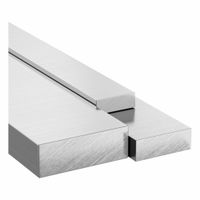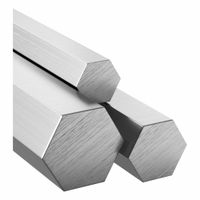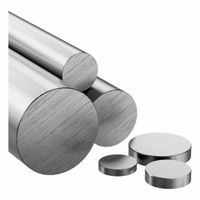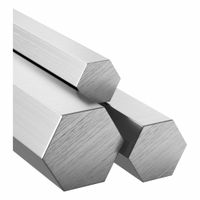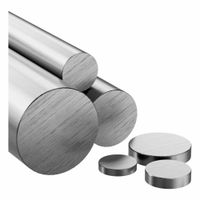Call +(254) 703 030 000 / 751 483 999 / 721 704 777
- Home
- Raw Materials
- Metals
- Stainless Steel
- Stainless Steel Bars Rods Discs
.....Read More
Frequently Asked Questions
What are the different grades of stainless steel bars, rods, and discs?
Stainless steel bars, rods, and discs are categorized into various grades based on their chemical composition and mechanical properties. The primary grades include:
1. **Austenitic Stainless Steels**:
- **304/304L**: Known for excellent corrosion resistance and formability. 304L has lower carbon content, enhancing weldability.
- **316/316L**: Contains molybdenum, offering superior corrosion resistance, especially against chlorides. 316L is the low-carbon variant.
- **310**: High-temperature resistance due to higher chromium and nickel content.
2. **Ferritic Stainless Steels**:
- **430**: Good corrosion resistance and formability, commonly used in automotive and appliance applications.
- **409**: Contains less chromium, used in exhaust systems due to its good oxidation resistance.
3. **Martensitic Stainless Steels**:
- **410**: Offers high strength and moderate corrosion resistance, used in cutlery and surgical instruments.
- **420**: Known for its high hardness and is often used in knife blades.
4. **Duplex Stainless Steels**:
- **2205**: Combines austenitic and ferritic properties, providing high strength and excellent resistance to stress corrosion cracking.
- **2507**: Super duplex with higher chromium and molybdenum content, offering enhanced corrosion resistance.
5. **Precipitation-Hardening Stainless Steels**:
- **17-4 PH**: Combines high strength and corrosion resistance, used in aerospace and chemical industries.
- **15-5 PH**: Similar to 17-4 PH but with improved toughness.
Each grade is selected based on specific application requirements, such as corrosion resistance, strength, temperature resistance, and formability.
How do stainless steel bars, rods, and discs resist corrosion?
Stainless steel bars, rods, and discs resist corrosion primarily due to the presence of chromium, which is a key alloying element. When stainless steel is exposed to oxygen, chromium reacts to form a thin, stable layer of chromium oxide on the surface. This passive film acts as a protective barrier, preventing further oxidation and corrosion of the underlying metal.
The chromium content in stainless steel is typically at least 10.5%, which is sufficient to maintain this protective oxide layer. If the surface is damaged or scratched, the chromium oxide layer can self-repair as long as there is sufficient oxygen available, ensuring continued protection against corrosion.
In addition to chromium, other alloying elements such as nickel, molybdenum, and nitrogen can enhance corrosion resistance. Nickel stabilizes the austenitic structure, improving toughness and resistance to certain types of corrosion. Molybdenum increases resistance to pitting and crevice corrosion, particularly in chloride-rich environments. Nitrogen can enhance the strength and pitting resistance of stainless steel.
The specific grade of stainless steel also influences its corrosion resistance. For example, 304 stainless steel is widely used for its good corrosion resistance and affordability, while 316 stainless steel contains additional molybdenum, offering superior resistance to chlorides and marine environments.
The manufacturing process, including proper heat treatment and surface finishing, also plays a role in corrosion resistance. Smooth, polished surfaces are less likely to trap corrosive agents, and proper heat treatment can optimize the microstructure for enhanced performance.
Overall, the combination of alloying elements, self-repairing passive film, and appropriate processing techniques enables stainless steel bars, rods, and discs to effectively resist corrosion in a variety of environments.
What are the common applications of stainless steel bars, rods, and discs?
Stainless steel bars, rods, and discs are versatile materials used across various industries due to their strength, corrosion resistance, and aesthetic appeal.
1. **Construction and Architecture**: These materials are used in structural components, reinforcements, and decorative elements like railings, facades, and sculptures due to their durability and resistance to weathering.
2. **Automotive Industry**: Stainless steel rods and bars are used in manufacturing exhaust systems, engine components, and structural parts, offering longevity and resistance to high temperatures and corrosion.
3. **Aerospace**: The high strength-to-weight ratio and corrosion resistance make stainless steel ideal for aircraft components, including fasteners, landing gear, and engine parts.
4. **Medical Equipment**: Stainless steel's biocompatibility and ease of sterilization make it suitable for surgical instruments, implants, and hospital equipment.
5. **Food and Beverage Industry**: Stainless steel discs and rods are used in food processing equipment, storage tanks, and kitchen utensils due to their non-reactive nature and ease of cleaning.
6. **Oil and Gas**: The material's ability to withstand harsh environments makes it suitable for pipelines, offshore platforms, and drilling equipment.
7. **Marine Applications**: Stainless steel's resistance to saltwater corrosion is ideal for shipbuilding, marine hardware, and coastal structures.
8. **Manufacturing and Tooling**: Used in the production of machinery, tools, and dies, stainless steel offers durability and precision.
9. **Energy Sector**: In nuclear and renewable energy, stainless steel is used for its strength and resistance to extreme conditions.
10. **Consumer Goods**: Everyday items like cutlery, watches, and appliances benefit from stainless steel's aesthetic and functional properties.
These applications highlight the material's adaptability and essential role in modern industry and daily life.
How do you choose the right stainless steel grade for a specific application?
To choose the right stainless steel grade for a specific application, consider the following factors:
1. **Corrosion Resistance**: Determine the environment the steel will be exposed to. For high corrosion resistance, especially in marine or chemical environments, consider grades like 316 or 317. For less corrosive environments, 304 may suffice.
2. **Mechanical Properties**: Assess the strength, ductility, and toughness required. For high strength, consider martensitic grades like 410 or 420. For applications needing high toughness, austenitic grades like 304 or 316 are suitable.
3. **Temperature Resistance**: For high-temperature applications, consider grades like 310 or 321, which maintain strength and resist oxidation at elevated temperatures.
4. **Fabrication Considerations**: Evaluate the ease of welding, machining, and forming. Austenitic grades like 304 and 316 are generally easier to form and weld. Ferritic grades like 430 are more challenging to weld.
5. **Cost**: Balance performance with budget constraints. Austenitic grades are generally more expensive due to higher nickel content. Ferritic and martensitic grades can be more cost-effective.
6. **Magnetic Properties**: If non-magnetic properties are required, choose austenitic grades like 304 or 316. Ferritic and martensitic grades are magnetic.
7. **Aesthetic Requirements**: For applications where appearance is important, consider the finish and polishability. Austenitic grades often provide a better finish.
8. **Standards and Certifications**: Ensure compliance with industry standards and certifications relevant to the application, such as ASTM, ISO, or specific industry requirements.
By evaluating these factors, you can select a stainless steel grade that meets the specific needs of your application, ensuring optimal performance and cost-effectiveness.
What are the differences between stainless steel bars, rods, and discs?
Stainless steel bars, rods, and discs differ primarily in shape, application, and manufacturing processes.
1. **Shape and Dimensions**:
- **Bars**: Typically have a rectangular or square cross-section. They come in various lengths and thicknesses, often used in construction and structural applications.
- **Rods**: Generally have a circular cross-section. They are long and cylindrical, used in applications requiring tensile strength, such as in fasteners and shafts.
- **Discs**: Flat, circular pieces of stainless steel. They are often used in applications requiring a flat surface, such as in flanges and fittings.
2. **Manufacturing Process**:
- **Bars and Rods**: Produced through processes like hot rolling, cold drawing, or extrusion. The choice of process affects the mechanical properties and surface finish.
- **Discs**: Typically cut from larger sheets or plates using methods like laser cutting, water jet cutting, or stamping.
3. **Applications**:
- **Bars**: Used in construction, automotive, and machinery for frameworks, supports, and braces.
- **Rods**: Common in manufacturing, automotive, and aerospace for components like bolts, screws, and axles.
- **Discs**: Utilized in industries like manufacturing and engineering for gaskets, seals, and pressure vessels.
4. **Properties**:
- All three forms share the inherent properties of stainless steel, such as corrosion resistance, strength, and durability. However, the specific properties can vary based on the alloy composition and treatment.
5. **Customization**:
- Bars and rods can be customized in terms of length and diameter, while discs can be tailored in terms of diameter and thickness to meet specific requirements.
These differences make each form suitable for distinct applications, optimizing performance and cost-effectiveness in their respective uses.
How are stainless steel bars, rods, and discs manufactured?
Stainless steel bars, rods, and discs are manufactured through a series of processes:
1. **Melting and Casting**: Raw materials, including iron ore, chromium, nickel, and other alloying elements, are melted in an electric arc furnace. The molten steel is then cast into semi-finished forms like billets, blooms, or slabs.
2. **Forming**: The semi-finished forms are hot-rolled or forged into bars and rods. Hot rolling involves passing the steel through a series of rollers at high temperatures to achieve the desired shape and size. Forging involves shaping the steel using compressive forces.
3. **Heat Treatment**: The formed bars and rods undergo heat treatment processes such as annealing, quenching, and tempering to enhance mechanical properties like strength, ductility, and hardness.
4. **Cold Working**: For certain applications, bars and rods may undergo cold working processes like drawing, peeling, or grinding to achieve precise dimensions and surface finishes.
5. **Cutting and Shaping**: Discs are typically cut from bars or rods using methods like sawing, shearing, or laser cutting. They may also be produced directly from slabs through stamping or forging.
6. **Surface Finishing**: The final products are subjected to surface finishing processes such as polishing, pickling, or passivation to improve corrosion resistance and aesthetic appearance.
7. **Quality Control**: Throughout the manufacturing process, rigorous quality control measures are implemented, including dimensional checks, surface inspections, and non-destructive testing to ensure compliance with industry standards.
8. **Packaging and Distribution**: Finished stainless steel bars, rods, and discs are packaged and distributed to various industries for use in construction, automotive, aerospace, and other applications.
What are the benefits of using stainless steel in structural applications?
Stainless steel offers several benefits in structural applications:
1. **Corrosion Resistance**: Stainless steel is highly resistant to corrosion, making it ideal for structures exposed to harsh environments, such as marine or industrial settings. This resistance extends the lifespan of structures and reduces maintenance costs.
2. **Strength and Durability**: It possesses high tensile strength and can withstand significant stress and strain without deformation. This makes it suitable for load-bearing applications and ensures long-term durability.
3. **Aesthetic Appeal**: Stainless steel has a modern, sleek appearance that is often used in architectural designs. Its ability to maintain a polished look over time enhances the visual appeal of structures.
4. **Fire and Heat Resistance**: Stainless steel retains its strength at high temperatures, providing fire resistance and maintaining structural integrity during fires, which is crucial for safety.
5. **Hygienic Properties**: Its non-porous surface is easy to clean and does not harbor bacteria, making it suitable for structures in healthcare and food processing facilities.
6. **Recyclability**: Stainless steel is 100% recyclable, contributing to sustainable construction practices. It can be reused without degradation of quality, reducing environmental impact.
7. **Low Maintenance**: Due to its resistance to rust and staining, stainless steel requires minimal maintenance, lowering long-term costs associated with upkeep and repairs.
8. **Versatility**: It can be fabricated into various shapes and sizes, allowing for flexibility in design and application. This adaptability makes it suitable for a wide range of structural uses.
9. **Impact Resistance**: Stainless steel can absorb significant energy from impacts, providing additional safety in structures subject to dynamic forces.
10. **Longevity**: The combination of these properties ensures that structures made with stainless steel have a long service life, offering a good return on investment over time.
